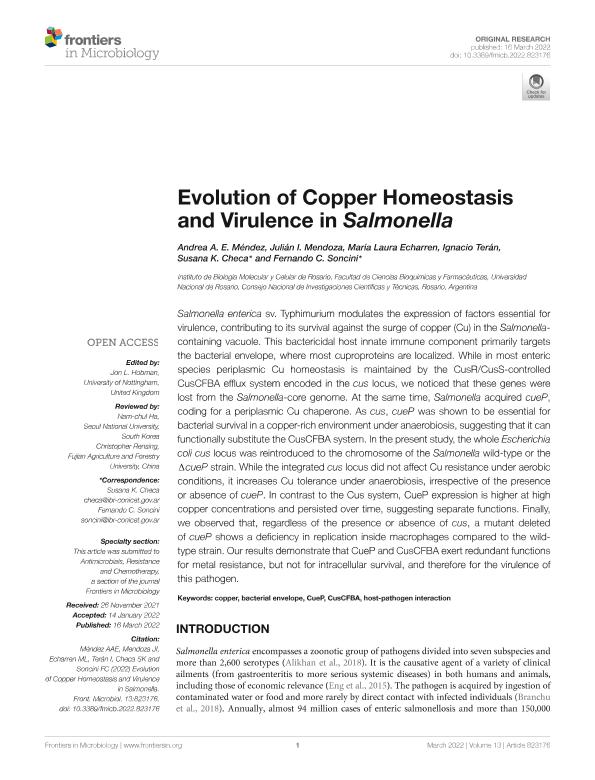Artículo
Evolution of Copper Homeostasis and Virulence in Salmonella
Mendez, Andrea Analia Elena ; Mendoza Fernández, Julián Ignacio
; Mendoza Fernández, Julián Ignacio ; Echarren, María Laura
; Echarren, María Laura ; Terán, Ignacio; Checa, Susana Karina
; Terán, Ignacio; Checa, Susana Karina ; Soncini, Fernando Carlos
; Soncini, Fernando Carlos
 ; Mendoza Fernández, Julián Ignacio
; Mendoza Fernández, Julián Ignacio ; Echarren, María Laura
; Echarren, María Laura ; Terán, Ignacio; Checa, Susana Karina
; Terán, Ignacio; Checa, Susana Karina ; Soncini, Fernando Carlos
; Soncini, Fernando Carlos
Fecha de publicación:
03/2022
Editorial:
Frontiers Media
Revista:
Frontiers in Microbiology
e-ISSN:
1664-302X
Idioma:
Inglés
Tipo de recurso:
Artículo publicado
Clasificación temática:
Resumen
Salmonella enterica sv. Typhimurium modulates the expression of factors essential for virulence, contributing to its survival against the surge of copper (Cu) in the Salmonella-containing vacuole. This bactericidal host innate immune component primarily targets the bacterial envelope, where most cuproproteins are localized. While in most enteric species periplasmic Cu homeostasis is maintained by the CusR/CusS-controlled CusCFBA efflux system encoded in the cus locus, we noticed that these genes were lost from the Salmonella-core genome. At the same time, Salmonella acquired cueP, coding for a periplasmic Cu chaperone. As cus, cueP was shown to be essential for bacterial survival in a copper-rich environment under anaerobiosis, suggesting that it can functionally substitute the CusCFBA system. In the present study, the whole Escherichia coli cus locus was reintroduced to the chromosome of the Salmonella wild-type or the ΔcueP strain. While the integrated cus locus did not affect Cu resistance under aerobic conditions, it increases Cu tolerance under anaerobiosis, irrespective of the presence or absence of cueP. In contrast to the Cus system, CueP expression is higher at high copper concentrations and persisted over time, suggesting separate functions. Finally, we observed that, regardless of the presence or absence of cus, a mutant deleted of cueP shows a deficiency in replication inside macrophages compared to the wild-type strain. Our results demonstrate that CueP and CusCFBA exert redundant functions for metal resistance, but not for intracellular survival, and therefore for the virulence of this pathogen.
Palabras clave:
BACTERIAL ENVELOPE
,
COPPER
,
CUEP
,
CUSCFBA
,
HOST-PATHOGEN INTERACTION
Archivos asociados
Licencia
Identificadores
Colecciones
Articulos(IBR)
Articulos de INST.DE BIOLOGIA MOLECULAR Y CELULAR DE ROSARIO
Articulos de INST.DE BIOLOGIA MOLECULAR Y CELULAR DE ROSARIO
Citación
Mendez, Andrea Analia Elena; Mendoza Fernández, Julián Ignacio; Echarren, María Laura; Terán, Ignacio; Checa, Susana Karina; et al.; Evolution of Copper Homeostasis and Virulence in Salmonella; Frontiers Media; Frontiers in Microbiology; 13; 3-2022; 1-11
Compartir
Altmétricas



